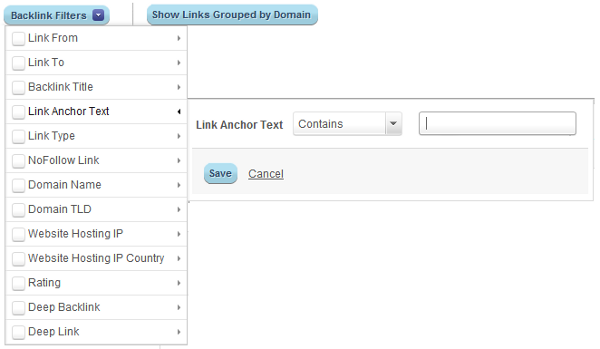Anchor text has always been a hot topic of discussion, but it’s not more important than ever thanks to Google’s algorithm changes that have affected link building. While most have known a natural link profile doesn’t equal a majority of links with targeted keyword based anchor text, it hasn’t stopped many SEO’s from pursuing keyword anchor text heavily in their link building efforts for clients and many times, by the client’s own request.
What Might Be Considered Natural Anchor Text
While there are lots of articles that examine percentages of what anchor text should be randomized and what percentage you can get away with that targets specific keyword phrases, the key is this. Natural is natural. There are no exact percentages when it comes to anchor text naturally occurring in the wild, or the Internet at least.
It all boils down to the fact that Google knows all websites are not run by SEO experts, and webmasters who are not SEO savvy typically don’t think to link to websites using a specific keyword phrase. If you were to look at a webpage by an average webmaster where they wanted to share their favorite websites on a particular topic, chances are they would be linking to those websites using the site’s name, the site’s URL, or something random like website or visit this site. For example, this website has a list of links, sometimes with an http://, but often times not.
Now that’s pretty natural. And here’s why you need to look for sites just like this when you’re link building.
How Non-Keyword Based Anchor Text Can Still Help With Rankings
Using the above example, none of the sites linked to need to have keyword anchor text like diabetes resources attached to them. Why? Because all of these links are on a website devoted to diabetes and on a page devoted to diabetes resources. Hence, when Google’s crawlers come to check out the links, they know that everything on that page should relate to diabetes and will probably credit the sites linked to diabetes resources. This is assuming, of course, that the rest of the links really are related resources.
So what can you learn from this? If you request the right links on relevant sites, you don’t need to worry about anchor text. So your goal in the quest for natural anchor text links will be to find sites that are highly relevant. This includes sites that are…
- Completely about a topic closely related to the one you are building links for like in the example above.
- Quality niche directories within the right category. Think a wedding photographers website linked in a wedding vendor directory.
- Strong local directories within the right category for local businesses.
- Blogs in a closely related topic.
Not asking for specific anchor text should make your job as a link building even easier. Instead of having to send specific details in your link requests, you only have to send something as simple as this.
Dear (insert website owner’s name here),
You have a great website on (insert topic here). I just thought I’d let you know about (insert name here) – they offer a lot of (insert information, products, or services here) that your visitors might be interested in. Their website is (insert url here) – I hope you find it a good fit!
Best regards,
You
The request now looks more friendly and less demanding like the typical ones where you’re telling webmasters exactly what you want them to place on their website.
When Keyword Anchor Text is Needed
Every link you build doesn’t necessarily have to be on a website that is closely related to yours. For example, if your website is about stock market quotes, you might want to build links by guest blogging on blogs to which investors are likely to subscribe. These blogs could have a wider business focus and cover many topics. This is a great time to use a keyword based anchor text as the link will not be on a website devoted to just stock market investing.
How You Can See Your Own Website’s & Competitor’s Anchor Text
There are lots of tools that will let you scroll through a list of backlinks and read through the anchor text. If you want to export a list into a spreadsheet, you can then group the links by anchor text and count them that way. Or you can use Cognitive SEO’s Backlink Reports which give you a convenient and easy to glance at anchor text cloud like this.
You can also use the list view of your backlinks by anchor text.
Essentially, this should give you an idea of what anchor text your website or competitors have used the most. If you notice that a high number have keyword-based anchor text (especially if it is over 60% for percentage lovers), then you should work towards building more links with natural, non-keyword based anchor text.

 Site Explorer
Site Explorer Keyword tool
Keyword tool Google Algorithm Changes
Google Algorithm Changes




Anchors and link popularity (number of BL) are still the most important factor in SEO. The only thing that change over the last years is the way that Google’s handle spam. But experienced spamers are still very efective.
They’re effective for now… I think Google’s doing a good job of cracking down on them though.
We agree with above facts, But when we clear our exact match domains link profile we saw drop in our ranking for that keyword. Every day Google is updating algorithms and it is really confusing. We are now mixing our link building profile, sometimes using exact anchor text, naked urls, variations of keywords with brand name. Here in this comment we used exact anchor text.
I think it’s a matter of using a healthy mix of anchor text along with making sure the links you get are on really relevant websites. So if you got a link on a webpage that included a list of WordPress designers, you probably wouldn’t need the exact match anchor text because Google could decipher that anything on that page related to WordPress designers. Kind of depends on the link and the situation.
Thanks for the information I also want to know once we see the anchor text cloud how should we analyze it with our competitor and what metrics we look for.